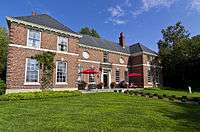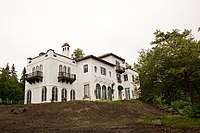William Lawrence Bottomley
William Lawrence Bottomley (February 24, 1883 - February 1, 1951)[1], was a noted architect in twentieth-century New York City; Middleburg, Virginia; and Richmond, Virginia. He is admired as one of the preeminent Colonial Revival designers of residential buildings in the United States and many of his commissions are situated in highly aspirational locations, including Monument Avenue in Richmond, Virginia.[2]
Education
Educated at the prestigious Horace Mann School in New York, Bottomley graduated from Columbia University in 1906 with a Bachelor of Science degree in architecture. In 1907 he studied at the American Academy in Rome, where he had received the McKim Fellowship in Architecture. In 1908 he entered the Ecole des Beaux-Arts in Paris, in the atelier of Victor Laloux, where he studied until he returned to the US to practice formally as an architect in 1909.[3]
Personal life
William Lawrence married Harriet Townsend, a sculptor and writer, on August 26, 1909 at Beech Hill in Westport, New York. Harriet's love for gardening may have influenced William's strong alliance with landscape architect Charles Gillette. William and Harriet had three daughters: Harriet, Susan, and Virginia.
Career
In his 40-year career, William designed 186 commissions, the majority of which (40%) were in Virginia.[2] "Bottomley's clients...while well-to-do, didn't have names with the lofty status of Rockefeller, Whitney, or Widener."[4] Eleven of Bottomley's commissions are currently listed individually on the National Register of Historic Places. Eight of these are in Virginia.[5]
William Lawrence Bottomley designed this residence (see right photo) at 155 Western Promenade in Portland, Maine.[6]


"Walter Davis, son of a prominent Portland family, was a graduate of Yale and of Harvard Law School. Very much a modern man in his professional life–as an attorney he was active in the affairs of banks and railroads in the state–he was, in his private life, a dedicated historian. For many years he was president of the Maine Historical Society, and like many of his generation and class, Davis was a dedicated Anglophile, visiting England regularly. His Cape Elizabeth summer house was a pure adaptation of a 16th-century Cotswold manor house. For his city house on Portland’s Western Promenade, he chose to visit the 18th century, evoking the England of Johnson and Boswell, by duplicating an English manor in the early 18th century style. For his architect, he chose William Lawrence Bottomley, a society architect noted for his sophisticated brick Georgian houses in Virginia and Long Island, in association with Leigh French, Jr., a New York architect-decorator best known today for his early books about Colonial interiors.
According to Maine State Historian Earle Shettleworth, Jr., who knew Davis, the model was a manor house that Davis had seen on a bicycle tour of England, likely the charming Stuart-style brick manor at Chipping Camden, whose design and composition were closely followed in the Davis house with a few differences–notably the balconet over the entrance, in the Portland house–as translated to a city lot. It was one of the last of the large houses built on the Western Promenade (1920), and its very proper Englishness added a new style note to the eclectic mix already present in the neighborhood. Inside, high paneled rooms; tall, deeply recessed windows; and Georgian chimneypieces made a reassuringly correct backdrop in which the Dowager Countess might feel at home, not surprising as Davis originally shared this house with his mother, who had formerly lived around the corner in the grand Edwardian mansion that John Calvin Stevens had designed for Walter Davis Sr. nearly four decades earlier."[7]
In 1918, young U.S. Army lawyer Walter G. Davis, Jr. worked with the American Commission to Negotiate Peace in Paris, resulting in the Treaty of Versailles, where Europe was divided after World War I. Two years later, he swept into fashionable 155 Western Promenade, with its 32-foot salon for entertaining; inset Grand Tour paintings collected by Davis during his travels; and a library featuring a priceless Zuber & Cie mural from Paris: the Boston panel of Views of North America.
His work is now the subject of the Historic Richmond Foundation's Year of Bottomley events.
Works
- 1912: Southampton High School (now Southampton Town Hall), Southampton, New York[8]
- 1915: 2324 Monument Avenue, Richmond, Virginia[9]
- 1918: 2309 Monument Avenue, Richmond, Virginia[9]
- 1920: 155 Western Promenade, Portland, Maine
- 1922–1924: addition to the Hotel Albert, New York City[10]
- 1923: 2315 Monument Avenue, Richmond, Virginia[9]
- 1923–1924: Blue Ridge Farm, Greenwood, Virginia
- 1924: Stuart Court Apartments, Richmond, Virginia[9]
- 1924: 2601 Monument Avenue, Richmond, Virginia[9]
- 1926: William and Helen Ziegler House, 116-118 E 55th Street, New York City[11]
- 1928: Casa Maria (addition), Greenwood, Virginia
- 1928: Dakota, Warrenton, Virginia
- 1929: Waverly Hill, Staunton, Virginia
- 1920s: 2320 Monument Avenue, Richmond, Virginia[9]
- 1920s: 2714 Monument Avenue, Richmond, Virginia[9]
- 1930s (remodeling): Rocklands, near Gordonsville, Virginia
- 1933–1935 (remodeling): Col Alto, Lexington, Virginia
- 1934: DeLeon F. Green House in the Weldon Historic District, Weldon, North Carolina[12]
- 1939: Newton White Mansion, Mitchelville, Maryland
References
- "The Grove Encyclopedia of American Art, Volume 1". Oxford University Press. Retrieved June 5, 2020.
- Katie Kelley, Architectural Historian, Historic Richmond Foundation
- Frazer, Susan Hume. The Architecture of William Lawrence Bottomley. New York: Acanthus Press, 2007.
- Calder Loth, Senior Architectural Historian, Virginia Department of Historic Resources
- "National Register Information System". National Register of Historic Places. National Park Service. July 9, 2010.
- 155 Western Promenade, Website.
- Brad Emerson, Downton Party, Portland Magazine
- https://www.google.com/books/edition/AIA_Architectural_Guide_to_Nassau_and_Su/H6sLhey465YC?hl=en&gbpv=1&dq=Southampton+High+School+design&pg=PA173&printsec=frontcover
- http://www.dhr.virginia.gov/registers/Cities/Richmond/127-0174_Monument_Avenue_HD_1989_Nomination_final_expansion.pdf
- ""Cultural Resource Information System (CRIS)"" (Searchable database). New York State Office of Parks, Recreation and Historic Preservation. Retrieved 2015-12-01. Note: This includes Anthony Robbins (September 2011). "National Register of Historic Places Registration Form: Hotel Albert" (PDF). Retrieved 2015-12-01. See also: "Accompanying photos".
- "WILLIAM and HELEN MARTIN MURPHY ZIEGLER, Jr. HOUSE" (PDF). Landmarks Preservation Commission. Retrieved 12 August 2020.
- Tom Butchko (March 1996). "Weldon Historic District" (pdf). National Register of Historic Places - Nomination and Inventory. North Carolina State Historic Preservation Office. Retrieved 2015-01-01.
Bibliography
- Susan Hume Frazer; William Lawrence Bottomley (2007). The architecture of William Lawrence Bottomley. Acanthus Press Llc. ISBN 978-0-926494-23-7.
- O'Neal, William Bainter and Christopher Weeks. The Work of William Lawrence Bottomley in Richmond.